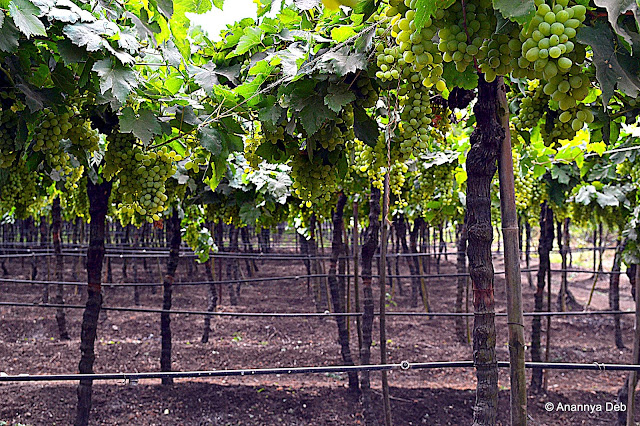India is blessed with a great diversity of ecosystems with varying climatic conditions that support the cultivation of many varieties of fruits. Some of these fruits are native to India, while others were introduced. Today, many of the fruits grown in the country are exported, earning the country considerable profits. Fruit cultivation also supports thousands of livelihoods across India. Over time, some places in the country have also become associated with a particular fruit and are even given nicknames associated with the fruit. Here are seven such places in India made famous by the fruits grown there.
Muzaffarpur, Bihar - Lychee
 |
| Lychees. Image credit: കാക്കര, via Wikimedia Commons |
The fleshy, juicy, sweet taste of lychee is available to lychee lovers for only a short period in summer. Yet, the taste lingers on the rest of the year. While lychee in the preserved form in drinks, ice creams, etc., might be in stock throughout the year, nothing compares to indulging in the fresh fruit itself, opening the pink-red outer cover to reveal the juicy pulp inside and popping it into the mouth. The rarity of lychee makes it even more delicious to its lovers, and hence, Muzaffarpur in Bihar must become one of their favourite places in the world. Yes, Bihar in India is the biggest lychee producer, with Muzaffarpur being a major hub of lychee trade. Hence, not surprisingly, it is nicknamed "the lychee basket of India" and "the lychee capital of India."
Malda, India - Mango
 |
| Himsagar mango from India at the Redland Summer Fruit Festival, Fruit & Spice Park, Homestead, Florida. Image credit: Asit K. Ghosh Thaumaturgist via Wikimedia Commons |
Bengal is not just famous for its sweet sweets but also for its sweet mangoes. Yes, Malda in West Bengal is from where India's juiciest, sweetest, most flavourful mangoes are derived. The fertile soil and conducive climate of the area yield the best quality mangoes in Malda. The many varieties, like Himsagar, Dudhiya, Langra, Lakshmanbhog, Fajli, etc., from Malda are all distributed across the country and also exported. Three of the varieties, Himsagar, Fajli, and Lakshmanbhog, have already been assigned the Geographical Indication (GI) tag by the central government, indicating the uniqueness of the varieties.
Nagpur, Maharashtra - Orange
 |
| Nagpur oranges. Image credit: Jim via Flickr.com. |
Nagpur is almost synonymous with oranges. The oranges grown in the region have also been assigned the GI tag in 2014, and why not? These oranges have a distinct taste and are fleshy, highly juicy, and sweet. Two varieties are grown by the farmers, one available from September to December called Ambiya and the other that is harvested in January called Mrig. The latter is the sweeter one.
Shimla, Himachal Pradesh - Apple
.jpg) |
| Apples growing on a tree. Image credit: Vinayaraj via Wikimedia Commons. |
Shimla's apple story is one that touches the heart. A man named Samuel Evans Stokes from Philadelphia, US, arrived in India around 1904. While visiting Shimla, he so fell in love with the beauty of the Himalayas and its people, that he made the place his home, married, and settled down. He also decided to give back to the place that had showered him with so much love and warmth. He introduced apple cultivation in a small village called Thanedar near Shimla. The conditions being ideal for the fruit, the apple plant flourished in the area and soon Shimla became a major exporter of apples in the country.
Nashik, Maharashtra - Grapes
 |
| A grape farm. Image credit: Anannya Deb via Flickr.com. |
Another entry from Maharashtra, Nashik is famous for its grapes that received the GI tag in 2010. Over 70% of India's exported grapes come from Nashik. The main varieties that are grown here are the Sonaka, Thompson seedless, and Sharad seedless. Grape cultivation was first introduced in the region in 1925 by a farmer called Ramrao J. Gaikwad in the town of Ojhar near Nashik. Since then, there has been no looking back. Today, over 1.75 lakh hectares of land in the region is dedicated to grape cultivation.
Beed, Maharashtra - Custard Apple
,_India.jpg) |
| Custard apples and bananas. Image credit: Melissa via Wikimedia Commons. |
Beed custard apples are another GI-tagged fruit. The cultivation of custard apples in the region was introduced by the Portuguese around the 16th century. These fruits are famous for their well-rounded shape, attractive external green colour, lesser number of seeds, and puply, juicy fruit that is high in nutritional value.
Vazhakulam, Kerala - Pineapple
 |
| Pineapples. Image credit: P.L. Tandon via Flickr.com. |
The presence of large-scale pineapple farms in and around Vazhakulam gives it the name "The Pineapple City of India." The pineapples produced here are also GI-tagged. They are famous for their pleasant aroma, high sugar, and low acid content, slightly conical shape, and bright yellow colour. Pineapples were introduced in India by the Portuguese, but their historical cultivation record in Kerala is not well documented. In 1995, a Pineapple Research Station was established in Vazhakulam, and the GI tag was granted to the pineapples in 2009.
No comments:
Post a Comment